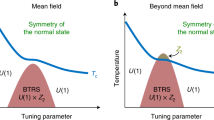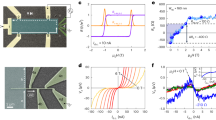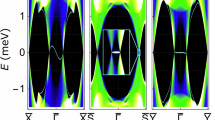Abstract
Superconductivity is a quantum phenomenon arising, in its simplest form, from the pairing of fermions with opposite spin into a state with zero net momentum. Whether superconductivity can occur in fermionic systems with an unequal number of two species distinguished by spin or flavour presents an important open question in condensed-matter physics or quantum chromodynamics1. In condensed matter the imbalance between spin-up and spin-down electrons that form the Cooper pairs is induced by the magnetic field. Such an imbalanced system can lead to exotic superconductivity in which pairs acquire finite momentum2,3. This momentum leads to a spatially inhomogeneous state consisting of periodically alternating ‘normal’ and ‘superconducting’ regions. Here, we establish that the hallmark of this state is the appearance of spatially localized and spin-polarized quasiparticles forming the so-called Andreev bound states (ABS). These are detected through our nuclear magnetic resonance (NMR) measurements.
This is a preview of subscription content, access via your institution
Access options
Subscribe to this journal
Receive 12 print issues and online access
$259.00 per year
only $21.58 per issue
Buy this article
- Purchase on SpringerLink
- Instant access to full article PDF
Prices may be subject to local taxes which are calculated during checkout





Similar content being viewed by others
References
Casalbuoni, R. & Nardulli, G. Inhomogeneous superconductivity in condensed matter and QCD. Rev. Mod. Phys. 76, 263–320 (2004).
Fulde, P. & Ferrell, R. A. Superconductivity in a strong spin-exchange field. Phys. Rev. 135, A550–A564 (1964).
Larkin, A. I. & Ovchinnikov, Y. N. Inhomogeneous state of superconductors. Sov. Phys. JETP 20, 762–769 (1965).
Maki, K. Effect of Pauli paramagnetism on magnetic properties of high-field superconductors. Phys. Rev. 148, 362–369 (1966).
Gruenberg, L. & Gunther, L. Fulde–Ferrell effects in Type-II superconductors. Phys. Rev. Lett. 16, 996–998 (1966).
Loh, Y. L. & Trivedi, N. Detecting the elusive Larkin–Ovchinnikov modulated superfluid phases for imbalanced Fermi gases in optical lattices. Phys. Rev. Lett. 104, 165302 (2010).
Loh, Y. L., Trivedi, N., Xiong, Y. M., Adams, P. W. & Catelani, G. Origin of excess low-energy states in a disordered superconductor in a Zeeman field. Phys. Rev. Lett. 107, 067003 (2011).
Bianchi, A., Movshovich, R., Capan, C., Pagliuso, P. G. & Sarrao, J. L. Possible Fulde–Ferrell–Larkin–Ovchinnikov superconducting state in CeCoIn5 . Phys. Rev. Lett. 91, 187004 (2003).
Koutroulakis, G. et al. Field evolution of coexisting superconducting and magnetic orders in CeCoIn5 . Phys. Rev. Lett. 104, 087001 (2010).
Singleton, J. et al. Observation of the Fulde–Ferrell–Larkin–Ovchinnikov state in the quasi-two-dimensional organic superconductor κ-(BEDT)2(CuSCN)2(BEDT-TTF ≡ bis(ethylene-dithio)tetrathiafulvalene). J. Phys. Condens. Matter 12, L641–L648 (2000).
Lortz, R. et al. Calorimetric evidence for a Fulde–Ferrell–Larkin–Ovchinnikov superconducting state in the layered organic superconductor κ-(BEDT-TTF)2(CuNCS)2 . Phys. Rev. Lett. 99, 187002 (2007).
Bergk, B. et al. Magnetic torque evidence for the Fulde–Ferrell–Larkin–Ovchinnikov state in the layered organic superconductor κ-(BEDT-TTF)2(CuNCS)2 . Phys. Rev. B 83, 064506 (2011).
Uji, S. et al. Vortex dynamics and the Fulde–Ferrell–Larkin–Ovchinnikov state in a magnetic-field-induced organic superconductor. Phys. Rev. Lett. 97, 157001 (2006).
Vorontsov, A. B., Sauls, J. A. & Graf, M. J. Phase diagram and spectroscopy of Fulde–Ferrell–Larkin–Ovchinnikov states of two-dimensional d-wave superconductors. Phys. Rev. B 72, 184501 (2005).
Agosta, C. C. et al. Experimental and semiempirical method to determine the Pauli-limiting field in quasi-two-dimensional superconductors as applied to κ-(BEDT-TTF)2(CuNCS)2: Strong evidence of a FFLO state. Phys. Rev. B 85, 214514 (2012).
Wright, J. A. et al. Zeeman-driven phase transition within the superconducting state of κ-(BEDT-TTF)2(CuNCS)2 . Phys. Rev. Lett. 107, 087002 (2011).
Kawamoto, A., Miyagawa, K., Nakazawa, Y. & Kanoda, K. 13C NMR study of layered organic superconductors based on BEDT-TTF molecules. Phys. Rev. Lett. 74, 3455–3458 (1995).
Mayaffre, H., Wzietek, P., Jérome, D., Lenoir, C. & Batail, P. Superconducting state of κ-(ET)2Cu[N(CN)2]Br. Studied by 13C NMR: Evidence for vortex-core-induced nuclear relaxation and unconventional pairing. Phys. Rev. Lett. 75, 4122–4125 (1995).
Mayaffre, H., Wzietek, P., Lenoir, C., Jérome, D. & Batail, P. 13C NMR study of a quasi-two-dimensional organic superconductor κ-(ET)2Cu[N(CN)2]Br. Europhys. Lett. 28, 205–210 (1994).
De Soto, S. M. et al. 13C NMR studies of the normal and superconducting states of the organic superconductor κ-(ET)2Cu[N(CN)2]Br. Phys. Rev. B 52, 10364–10368 (1995).
Abragam, A. Principles of Nuclear Magnetism (Oxford Univ. Press, 1999).
Clem, J. R. & Coffey, M. W. Viscous flux motion in a Josephson-coupled layer model of high-Tc superconductors. Phys. Rev. B 42, 6209–6216 (1990).
De Soto, S. M., Slichter, C. P., Wang, H. H., Geiser, U. & Williams, J. M. Evidence for the role of fluxoids in enhancing NMR spin–lattice relaxation and implications for intrinsic pinning of the flux lattice in organic superconductors. Phys. Rev. Lett. 70, 2956–2959 (1993).
Mansky, P. A., Chaikin, P. M. & Haddon, R. C. Vortex lock-in state in a layered superconductor. Phys. Rev. Lett. 70, 1323–1326 (1993).
Mansky, P. A., Chaikin, P. M. & Haddon, R. C. Viscous flux motion in a Josephson-coupled layer model of high-Tc superconductors. Phys. Rev. B 50, 15929–15944 (1994).
Won, H. et al. Upper critical field and Fulde–Ferrell–Larkin–Ovchinnikov state in CeCoIn5 . Phys. Rev. B 69, 180504(R) (2004).
Wang, Q., Chen, H-Y., Hu, C-R. & Ting, C. S. Local tunneling spectroscopy as a signature of the Fulde–Ferrell–Larkin–Ovchinnikov State in s- and d-wave superconductors. Phys. Rev. Lett. 96, 117006 (2006).
Yanase, Y. & Sigrist, M. Antiferromagnetic order and π-triplet pairing in the Fulde–Ferrell–Larkin–Ovchinnikov state. J. Phys. Soc. Jpn 78, 114715 (2009).
Cui, Q., Hu, C-R., Wei, J. Y. T. & Yang, K. Spectroscopic signatures of the Larkin–Ovchinnikov state in the conductance characteristics of a normal-metal/superconductor junction. Phys. Rev. B 85, 014503 (2012).
Urayama, H. et al. A new ambient pressure organic superconductor based on BEDT-TTF with T C higher than 10 K (T C = 10.4 K). Chem. Lett. 17, 55–58 (1988).
Acknowledgements
We would like to thank A. Vorontsov, Y. Yanase and M. Sigrist for illuminating discussions, and I. Sheikin for providing raw data for the phase diagram. This research is supported by funds from the French ANR grant 06-BLAN-0111, the EuroMagNET II network under EU Contract No. 228043, the visiting faculty program of Université Joseph Fourier (V.F.M.), and ADVANCE HRD-0548311 (V.F.M.).
Author information
Authors and Affiliations
Contributions
K.M. and K.K. prepared the samples. H.M., S.K., K.M. and V.F.M. performed the experiments. S.K. and M.H. developed and operated the high-field NMR facility. H.M. created software for the spectrometers. H.M. and V.F.M. analysed the data. C.B. provided conceptual advice and contributed to the planning of the project. H.M., C.B., M.H. and V.F.M. developed the data interpretation. V.F.M. wrote the paper and supervised the project. All authors discussed the results and commented on and edited the manuscript.
Corresponding author
Ethics declarations
Competing interests
The authors declare no competing financial interests.
Supplementary information
Supplementary Information
Supplementary Information (PDF 1518 kb)
Rights and permissions
About this article
Cite this article
Mayaffre, H., Krämer, S., Horvatić, M. et al. Evidence of Andreev bound states as a hallmark of the FFLO phase in κ-(BEDT-TTF)2Cu(NCS)2. Nature Phys 10, 928–932 (2014). https://doi.org/10.1038/nphys3121
Received:
Accepted:
Published:
Issue date:
DOI: https://doi.org/10.1038/nphys3121
This article is cited by
-
Evidence of finite-momentum pairing in a centrosymmetric bilayer
Nature Physics (2023)
-
Unconventional pairing in few-fermion systems at finite temperature
Scientific Reports (2022)
-
Emergent anisotropy in the Fulde–Ferrell–Larkin–Ovchinnikov state
Nature Communications (2022)
-
Evidence for the Fulde–Ferrell–Larkin–Ovchinnikov state in bulk NbS2
Nature Communications (2021)
-
Fulde–Ferrell–Larkin–Ovchinnikov and vortex phases in a layered organic superconductor
npj Quantum Materials (2019)



